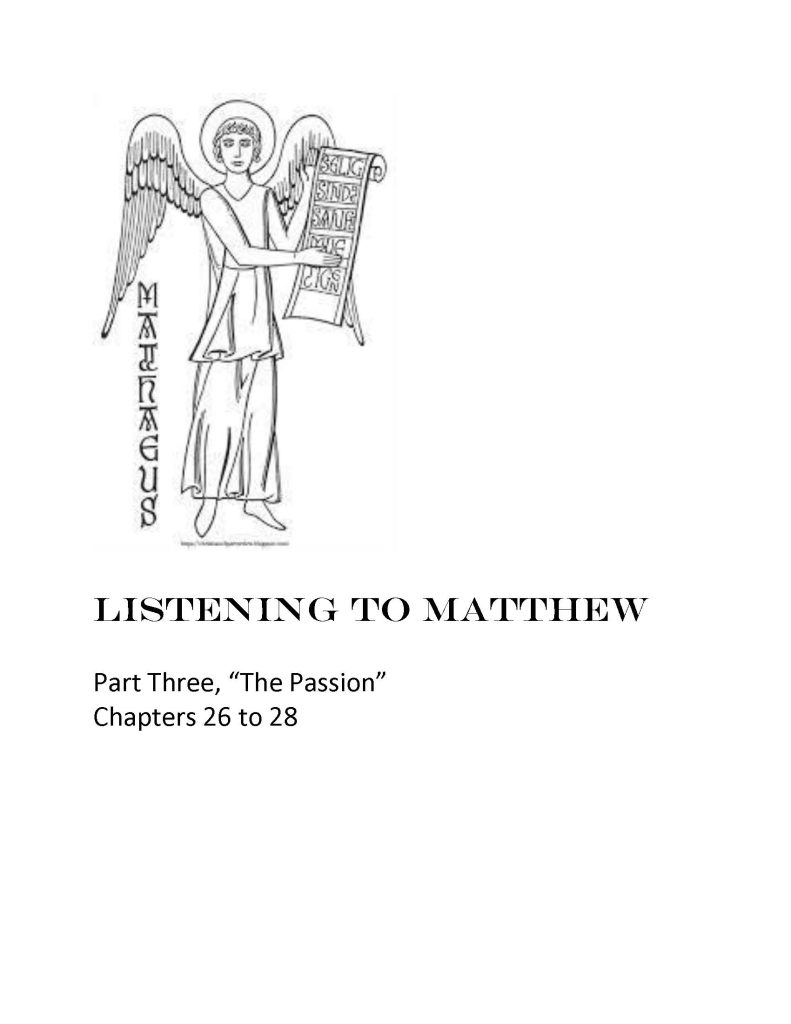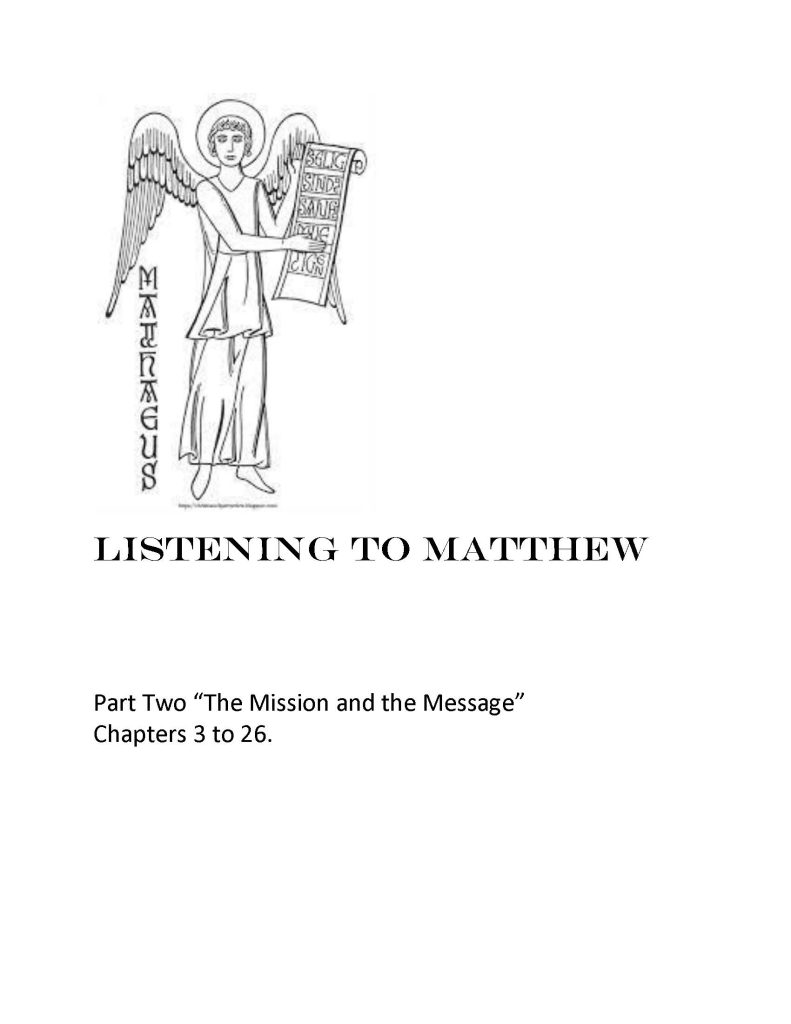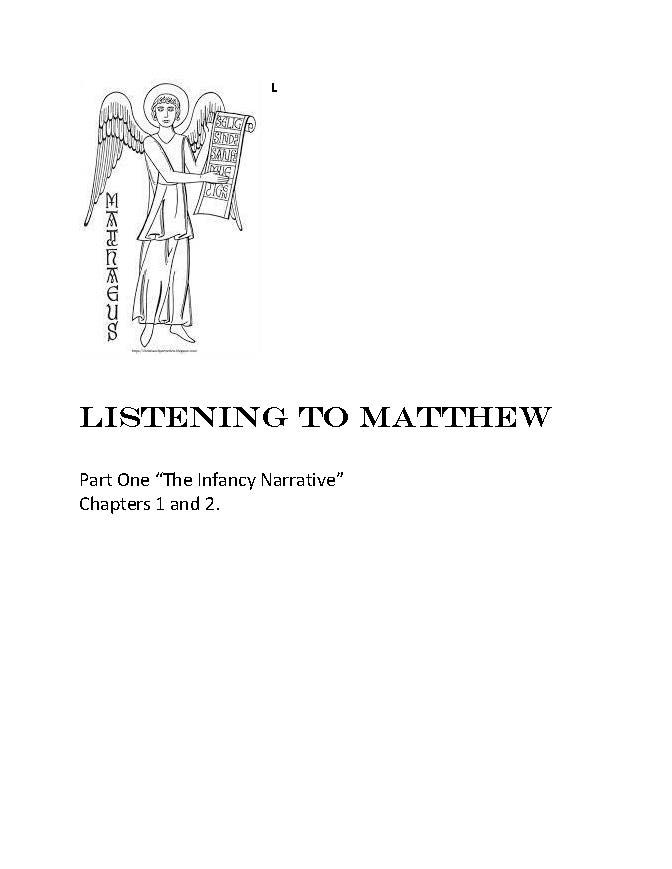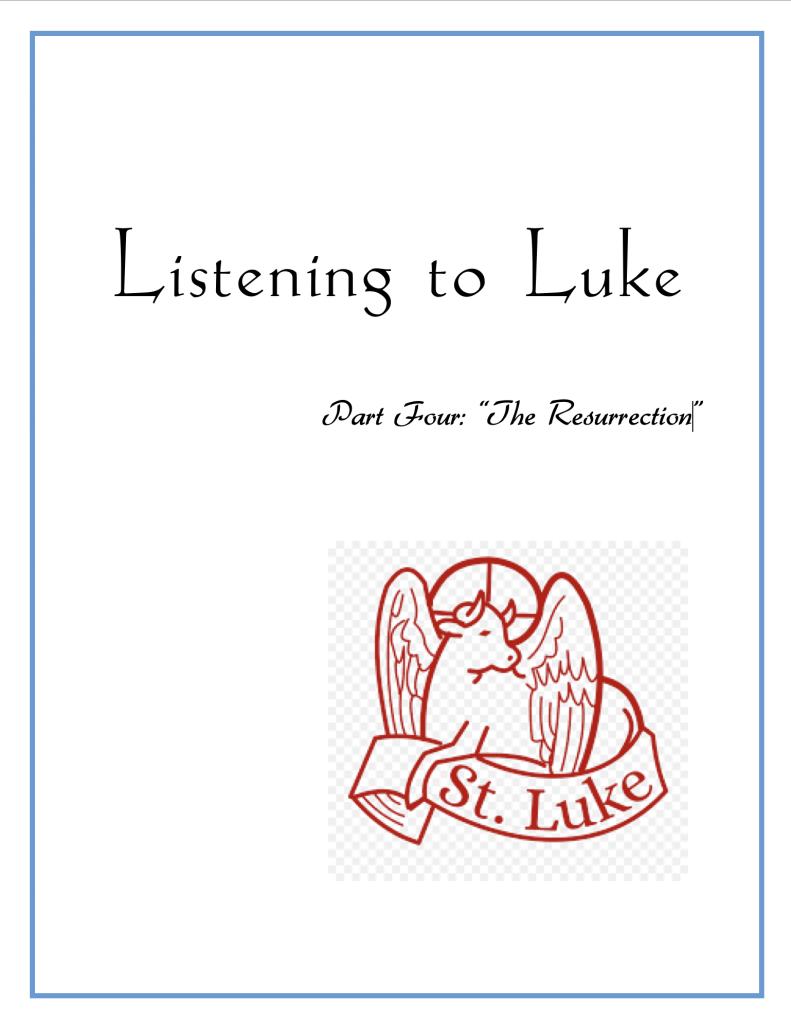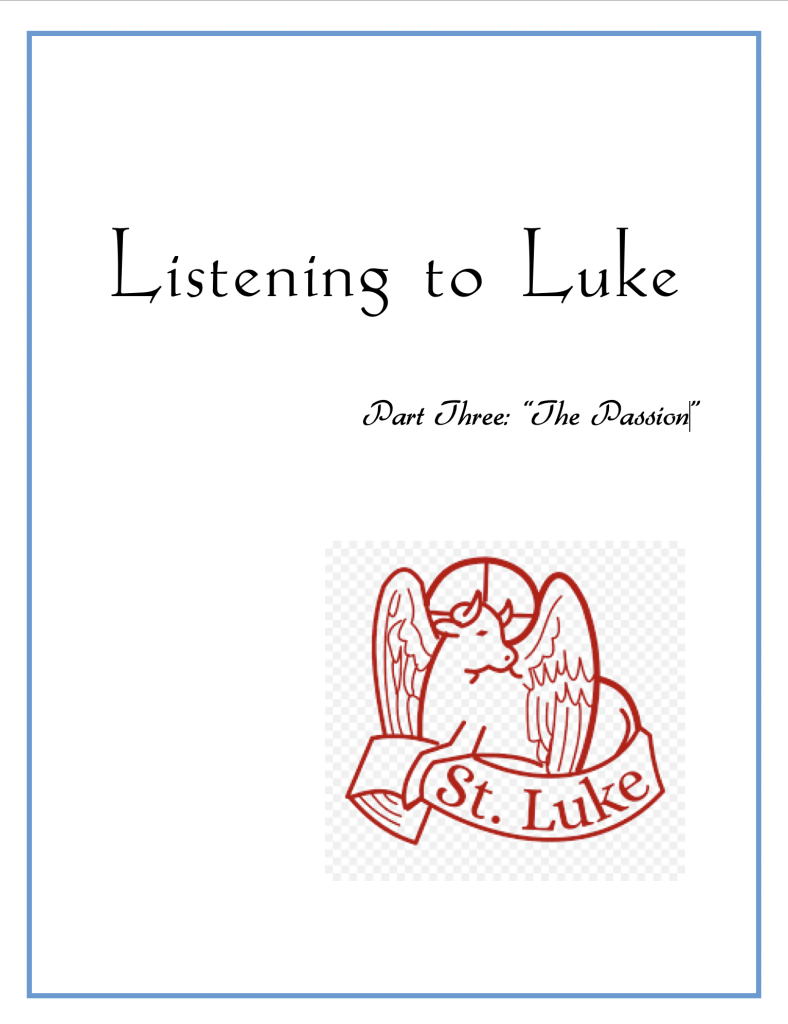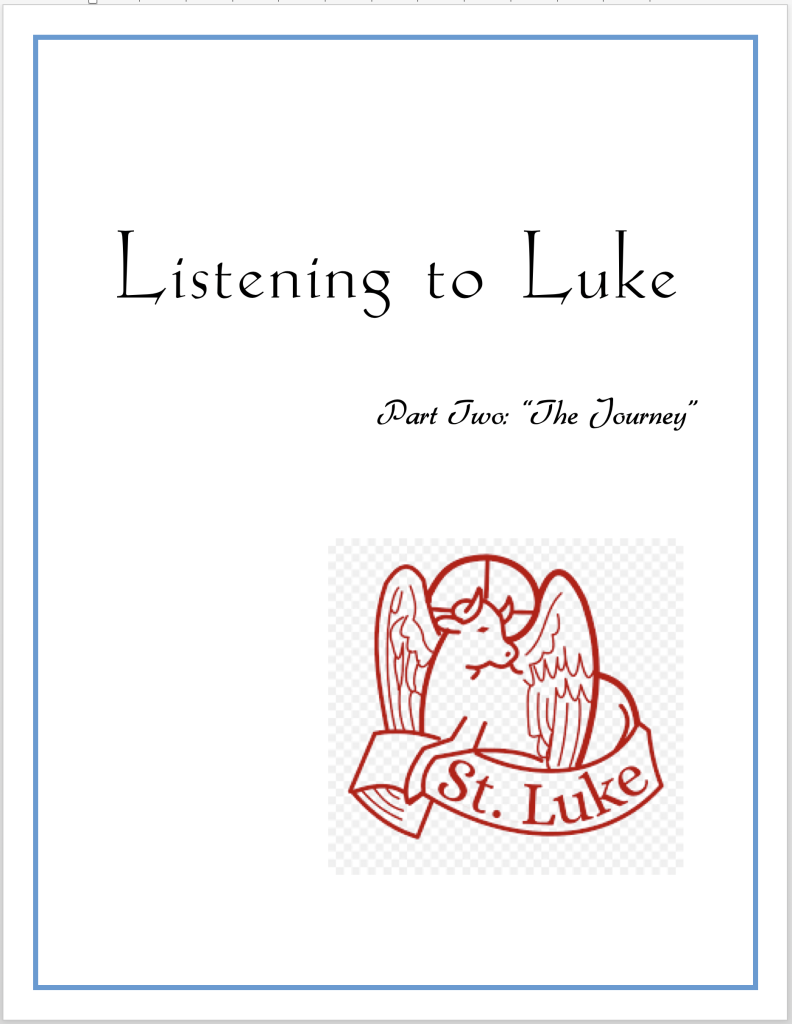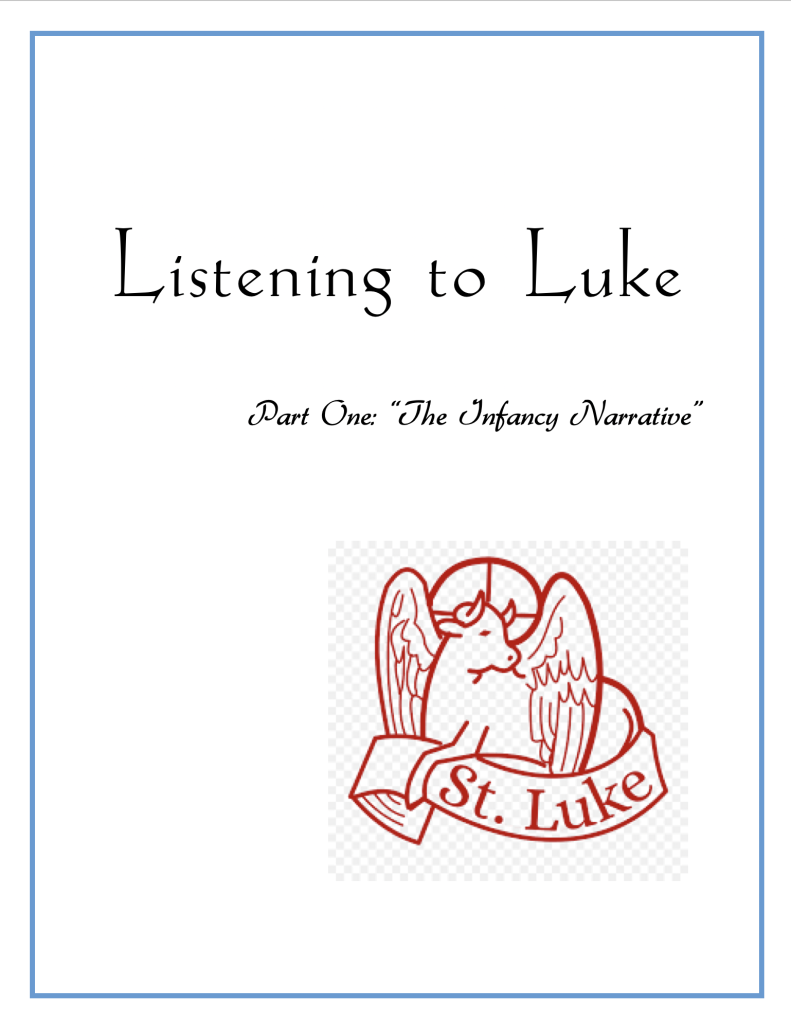| 1 The Ministry in and around Galilee (1:14 to 8:26)2 The Journey to Jerusalem (11 to 13)3 The Passion (14 to 15) |
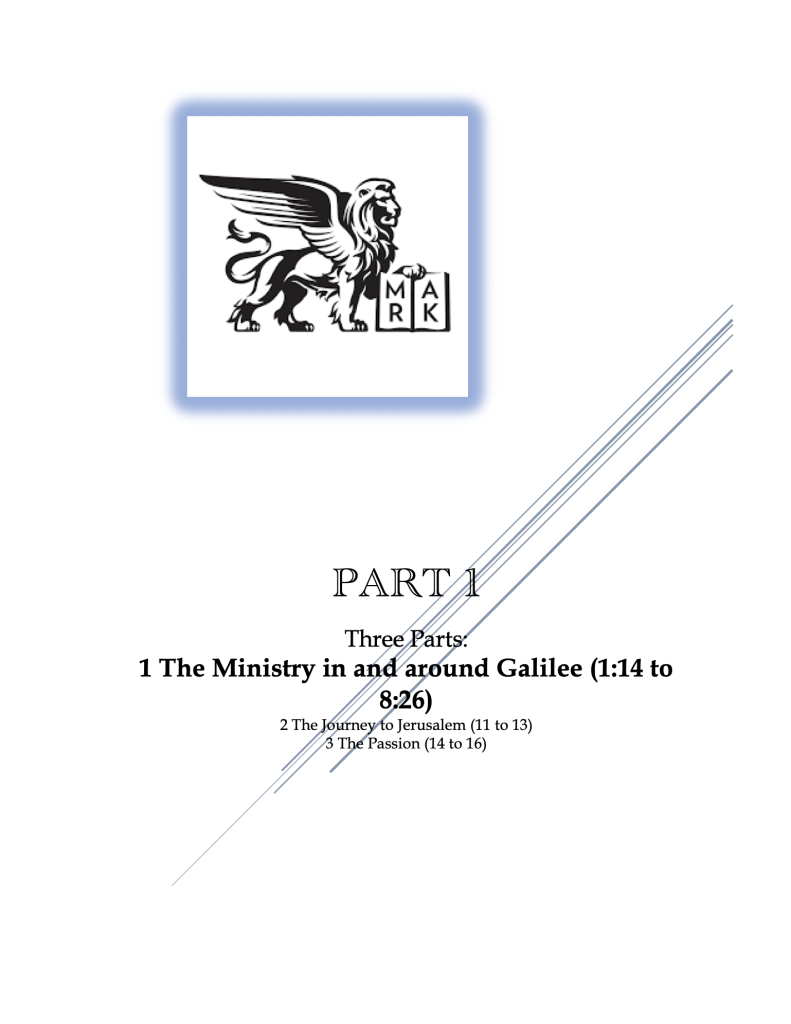
LISTENING TO MARK PART ONE
Three Parts:
1 The Ministry in and around Galilee (1:14 to 8:26) Pages 1 to 7
2 The Journey to Jerusalem (8:26 to 13) Pages 8 to 14
3 The Passion (14 to 15) Pages 15 to 21
As we pick the Gospel of Mark as we did the First Sunday in Advent, we absolutely must keep in mind that this is not history. This is theology. We must avoid the temptation to wonder if Jesus really said this or that, if something really happened or if he really did something. For that matter, it is silly and waste of time to wonder how it did something. That is serious distraction that will rob us of the wonder and truth of what is being revealed. All of the Gospels owe their existence to the fact that the eyewitnesses were dying, and those who actually saw and heard Jesus speak were fast disappearing. Different from Matthew and Luke, Mark’s Gospel does not have time for Christmas. He is not writing a heart-warming story. In fact, you could say that he doesn’t have time for that sort of thing. It is a Gospel written in almost desperate haste, and you get that feeling right away.
Mark is giving us a testimony to the church in crisis, and for me, this Gospel is as timely and important as it ever was. We may not be suffering great violent persecutions here, but there is plenty of it elsewhere. Yet, in my opinion, we are suffering persecution of a new sort. It is not violent, but it can be just as painful and distressing. Our persecution takes a different form. It is a subtle kind of emotional invalidation. There is little respect for what we believe and value most. Disregarded and blatantly ignored, we are sometimes simply dismissed as pious fools over looked and dismissed. It is a crisis if we care to take it seriously, and Mark’s Gospel speaks to that now just as he did to that early church in its suffering.
Rome, the center of Gentile civilization is the ultimate and final destination of Peter and Paul. Probably there, as a companion of Paul and a disciple of Peter, a man tradition has called, “Mark” set about the task of putting into writing what he could gather from Peter and any others who had actually heard Jesus speak. There is every reason to believe that Mark had some earlier writings now lost to us that would have recorded things Jesus said and things Jesus did. But for the most part, this is a one-source Gospel and the preaching of Peter is the source.
As a piece of literature, it is short, blunt, and somewhat clipped in style. In some instances, the details vary from the other Gospels when describing the same incident. At first it seems to be a chronological report of the Lord’s life, but in the end, it is almost chaotic as it seems to dart abruptly from one location to another. Considering the source, what we have are the memories of the aging Peter. Mark, careful to leave nothing out, gives us Peter with no addition or subtraction. As a piece of literature then, it is a simple and direct record of what was remembered from what Jesus said and did. This is not to imply that somehow Mark’s Gospel is inferior to Matthew and Luke. On the contrary, he was actually a pioneer and preserved for us material that might have been lost had it not been for his writing. He selected, adapted, and presented traditional material, and he arranged it with great care. He wrote for a community with a firm Christian tradition knowing what he was about with great theological sophistication.
This Gospel is written more as a sermon that serves to motivate. So, by telling the story of Jesus, Mark challenges readers to faithful discipleship. He wants to reveal God’s plan of salvation, and he presents that in and through the life of Jesus Christ. It is through human life that God saves the world. Ultimately it is a call to action that is most clearly heard at the conclusion as a call to action and conversion. His focus is on one’s personal choice to act.
When he wrote, a decision to become a follower of Jesus was very radical. It could mean disapproval and outright rejection from friends and family. It could require close fellowship with people previously shunned, slaves, Roman soldiers, Jewish nationalists, and public sinners. For the educated it could mean being laughed at for the absurdity of following a carpenter from a backwater village who was executed as a criminal. For some it could also mean imprisonment, torture, and death by the brutal Romans. Mark himself is one of these people whose life has been changed. He is excited about it, full of joy, and anxious to share his “good news”.
He was writing for a mixed community with Gentile and Jewish backgrounds. Where they are is only a guess. Mark is not preoccupied with geographical precision. However, they are somewhere in the Roman Empire, probably Syria, which would be close to the events of the Jewish War. Because he is aware of the Gentile converts he takes great care to translate Jewish expressions, customs, and Aramaic expressions for those living in Rome. He wants to knit these two peoples closer together with Jesus as the bond of that union. Most believe it was written soon after or immediately after the destruction of Jerusalem in the year 70. This traumatic event raised a problem for Mark’s community which he had to face. Some believed that the destruction of the Temple would be followed immediately by the end of the world, and that did not happen. This makes Mark very conscious of living “between the times.” Victory is the destiny of the faithful, but life in the here and now is real, and it can be grim.
Of special concern for Mark is the power of Imperial Rome as he stresses over and over again the deeds, the strength, and the determination of Jesus to overcome evil forces. Conflict is constant in Mark’s Gospel, and Jesus is the cause of it. He is in conflict with the authorities both religious and political. There is conflict with the disciples who are overwhelmed by Jesus and his demands. They are hard of heart and full of fear. They constantly misunderstand. In the end, they fail him. As with Matthew, Luke, and John, the ultimate focus and the motive for writing is the Passion, which may have been written first with the other chapters, written later, leading and pointing toward the Passion. One third of this Gospel is devoted to the last week of Jesus’s life.
“Who is this?” is the question that drives Mark’s Gospel from the moment Jesus brings calm to the sea up to the moment when Peter finally speaks up and expresses the faith of the apostles, and on to one final moment at the death of Jesus. One of the most striking elements in this Gospel is the reluctance of Jesus to reveal himself as Messiah. He only refers to himself as the “Son of Man”. Jesus calls disciples to faith that requires suffering, and so until they pass through the suffering, there is to be no talk or mention of who he is. This is what gives rise to what students of Mark’s Gospel call “The Messianic Secret.” Yet, we know the secret and so do the first readers of Mark’s Gospel. What unfolds in this Gospel by watching the characters who do not know what we know is an unfolding of what Jesus must undergo and what that means for those who follow him.
Mark is a storyteller with an eye for detail especially in the miracle stories. Details are abundant and given in a vivid style, and one incident follows on another in an almost breathless narrative. He also shows himself to be a rare and fine theologian.
More than any other Gospel, Mark emphasizes the miracles, healings, and exorcisms of Jesus. There are 678 verses in Mark, and 1/3 (198) recount miracles. If you like numbers and statistics, there are 18 miracles stories. Thirteen of these are healing stories. The rest are exorcisms. In our day, these raise some questions: Did those events really occur by supernatural intervention? “Do demons really exist?” “Do miracles happen today?” In Mark’s day, these were not questions. Demons existed and troubled people, and there were miracles everywhere. So, Mark never addresses those questions. Supernatural intervention, while extraordinary, was common to the time, and attributing certain illnesses to demons was equally common. We cannot go further with this without my reminder, something I have said time and time again in these talks about the Gospels. “This is not history! This is theology.” It is ridiculous to ask “What really happened?”. That is simply a distraction from what matters, and why we have the Gospel. There is no way to answer that question. What matters is, “What did this happening really mean?”
With that, let us step into the Gospel of Mark.
The opening verse provides the title: “The Good News,” and for Mark, Jesus is himself the Good News that God has sent his Son to rescue humanity by serving and sacrificing his life. There is no infancy narrative. Mark has no interest in what happened before the Baptism of Jesus. For Matthew and Luke, the identity of Jesus is the point of their Nativity stories. They want to introduce Jesus through a location, his family, and the witnesses (Shepherds in Luke, Magi in Matthew). Mark accomplishes that with John the Baptist.
This story of Jesus begins in the wilderness of Judea. We have no idea where that is on the map, but the location has profound theological significance. The Baptist appears like Elijah to prepare the way. At the ninth verse, Jesus is introduced, to be baptized, and to be tempted. This is Mark’s way of establishing the identity and the authority of Jesus with a hint about what is to come as Jesus moves into Galilee.
The ministry in Galilee is dominated by one question: “Who is this?”. A series of remarkable events and words of Jesus raise the question. Jesus never declares his identity. Demons know, but they are silenced by Jesus who simply offers himself and his teaching for individual decisions and commitment. “Whoever has ears to hear, let them hear.”
The ministry in Galilee has three parts, and the transition from one part to the next is marked by a response to Jesus. The first part concludes at chapter 3 verse 6: “The Pharisees went out and immediately conspired with the Herodians against him, how to destroy him.” The second part concludes at chapter 6 verse 3: “Is not this the carpenter, the son of Mary and brother of James and Joses and Judas and Simon, and are not his sisters here with us? And they took offense at him.” Again, he moves on after recognizing their rejection. Part three concludes the Ministry in Galilee and leads up to the climactic moment when Peter declares that Jesus is the Messiah. With that, everything changes, the pace picks up, and Jesus heads toward Jerusalem. That’s the end of the ministry in Galilee.
With that outline understood, it only takes Mark 9 verses to establish the identity of Jesus. It happens at the Baptism which, in Mark, is not a public affair. The whole event is simple and direct, it is the Epiphany moment in this Gospel establishing the identity and authority of Jesus of Nazareth. It occurs by a vision and a voice. A verb in the passive voice is used by Mark here: “The heavens were torn open.” It is the same verb used when the Temple Veil is “torn” from top to bottom. In both cases, what has been closed is now open. The mention of the Spirit descending suggests that Jesus is greater than John, and that Jesus will Baptize with the Spirit. Both the vision and the voice are intended for Jesus alone. There is no mention that anyone else was present or heard the voice. This is a secret epiphany. Jesus knows who he is by means of an experience that is not available to the public. They must discover his identity by listening to what Jesus says and by watching what he does. The centurion who watches Jesus die will confess publicly what is here revealed privately: Jesus is the Son of God. The entire story that follows is the story of Jesus and of what God did through him. We ought to think about this in terms of our own Baptism. It establishes our identity.
That Spirit descending upon him immediately drives him out into the wilderness. Mark says nothing about fasting, and there are no details about temptations. There is nothing said about the outcome of the struggle either. What matters here is the number 40 as a reminder of Israel’s forty days in the wilderness and the forty days Moses spent on Sinai. The wilderness is a place where the forces hostile to God are found. Yet, God is present there too. The Greek word translated as “tempt” can also mean “test”. It is not likely that Mark would suggest that Jesus was “tempted” to sin. On the contrary, since conflict is so much a part of Mark’s Gospel, it would be much clearer to say that Jesus was “put to the test” which is a very different experience.
Then, almost as though Jesus waits for the Baptist to finish his work, Mark simply says that Jesus came to Galilee proclaiming the good news of God. For Mark, it’s all about proclaiming which includes preaching and teaching. In the first verse of Chapter One, it is the “good news of Jesus Christ.” Now in verse 14 it is the “good news of God”. Mark tells us about Jesus. Jesus tells us about God.
Announcing that “the time is fulfilled” has several dimensions of meaning. At that time and in that place, God stepped into human history in a decisive way. The time is fulfilled. Ours is an invaded planet. Mark links the time of John’s arrest with the time when Jesus starts preaching the gospel. The time of the prophet is over. Now it’s the time of Jesus. Finally, when the good news of God is preached, it is decision time: The time is fulfilled. The other Gospels have Jesus speak of a Kingdom that is present, already here. The Jesus of Mark’s Gospel speaks of a Kingdom that is about to appear. So, it’s decision time, repent and believe. “Time is up!”
It is hard not to answer a ringing phone, and that is a good way to enter into this first incident in the public ministry of Jesus. He calls. The memory of this among the earliest Christians was a treasure. This story must have been used in the earliest preaching of the Church. With it, the second major concern of this Gospel after Jesus himself is introduced: this group of fishermen. It is told with sharp details making it easy to visualize. It’s all vivid and fresh: five personal names, the Sea of Galilee, the nets, the boats, hired servants, casting, and mending. This is their first encounter with Jesus making their quick response so remarkable. The only words are from Jesus. He calls. They follow. We don’t know anything about them, about their work or how they got along. Mark is interested in only one thing: the authority of Jesus and the response of disciples. In other words: What does Jesus say, and how will they respond.
It can be said that one purpose of Mark’s Gospel is to allow us to participate with the first disciples of Jesus in the gradual and growing recognition of who he is until we reach the conclusion to which the demoniac points in the first of the conflicts. It happens in a synagogue. Jesus first confronts and defeats the power of evil in the place of worship of the people of God. The scribes belong there. The unclean spirit does not. The presence of Jesus is a confrontation with both the Scribes, who have no authority compared to Jesus, and the unclean spirit. What is affirmed here is the amazing authority of Jesus which shows itself in teaching and a special kind of healing that shows itself as power over forces hostile to God.
There is a lot going on in Capernaum. First an exorcism in the synagogue, and then later that day at the home of Simon and Andrew there is a healing in Peter’s home. One involves a man and the other involves a woman. Then there are more healings in the evening that leads to the closing sentence: “He would not permit the demons to speak because they knew him. This is the first report of what is often called: “The Messianic secret.” With that day at an end, Jesus goes off to pray. The disciples track him down and want him to return to the crowds for more healing. Jesus insists that the goal of his ministry in Galilee is to preach. “That is why I came” he says.
Having established why he came and confirming his authority, a preaching tour begins, and with the first healing on this tour, the roll of faith is introduced. Mark gives us a glimpse into the motivation of Jesus who was “moved with pity” at the sight of a leper. However, more is being revealed in this episode. The words of Jesus, “I will” affirm that God wills healing, and that Jesus comes as the great physician. Then comes the stern command not to tell anyone because he wants to be known as more than a miracle worker. The crowds gathering are a hindrance to his mission.
With the first event in Chapter Two, the term, “Son of Man” is introduced, a connection between sickness and sin is raised, and the first rumblings of a conflict are heard as the scribes appear. The setting is important. Mark tells us that Jesus is “at home.” Something different from other healing stories happens here. There is no touching and no request as a paralytic is lowered through the roof. Jesus recognizes faith and says, “My son, your sins are forgiven.” With that the authority of Jesus is revealed and the fuse of controversy is lit. As proof Jesus then says, “Take up your mat and walk.” What we have here is a revelation of God’s forgiveness and the authority of Jesus. There is no evidence that the man had faith, but it is clear that the friends did. Their faith plays an important role.
As this first part of the Gospel continues, Levi is called, and Mark tells of growing controversy over eating with sinners and fasting. We know nothing about Levi, and he is never listed among the apostles. All we know is that Jesus calls him even though he is an outcast and therefore a sinner. Jesus eats with him. The episode provides us with a pronouncement: “I came not to call the righteous, but sinners.” A controversy over fasting follows and provides another pronouncement: “Fresh skins for new wine.” We can only imagine how encouraging these pronouncements were to the early Church in its struggle between Gentile converts and faithful Hebrew converts hanging on to their old ways. It suggests something we know to be true but may need a reminder: Relationships are healed when people eat together. Then comes a sabbath healing of a man with a withered hand adding to the controversy. Growing opposition from religious leaders leads Jesus and his disciples to withdraw from danger. The crowd follows and Mark gives us a sense of that crowd by listing the places from which they come. It becomes a sort of “State of the Ministry” report, but the crowds have no idea who Jesus is. The unclean spirits do.
After removing Jesus from the crowd, Mark uses a verb that is translated in various ways: made, ordained, appointed, named, or chosen. The object of this verb is simply “twelve.” This is a tricky spot in the Gospel because the persons named are both disciples and apostles, “the twelve” in Mark means something more than “the disciples” but something less than the “apostles.” Mark gives their names, but three of them get surnames. They become an inner circle among the twelve. With that, this section ends as Mark writes: “Then Jesus went home.”
In Chapter Three, the Kingship of Jesus becomes the focus. What we see is that Jesus leaves his identity up to the crowds, the religious leaders, the disciples, and his own family. So, it begins in a “home.” The religious leaders accuse him of working with Satan. His family accuse him of being out of his mind. Two important pronouncements emerge from this episode: one comes from the family confrontation when Jesus says: “Here are my mother and my brothers! Whoever does the will of God is my brother, and sister, and mother.” The second pronouncement concerns the “unpardonable sin.” That sin is to recognize a supernatural power at work in Jesus and yet to call that power unclean or evil. It is unforgiveable because it rejects the very agent of God’s healing and forgiveness. Mark uses the imperfect tense of the verb here, and that is significant, “Because they were saying he has an unclean spirit” suggests that this is a habitual action, a fixed attitude, a firm decision not just skepticism. It is deliberate, and that’s what is so sinful. It is the obstinate rejection of God’s Holy Spirit alone that is unforgiveable. Only those who set themselves against forgiveness are excluded from it.
Now he moves to the lake where he begins to teach in parables. There are three of these: two about seeds and one about light. Mark wants us to understand that there is a large crowd, and Jesus is presented as a “Teacher.” This is the first and longest of the teaching moments, and the location suggests that Jesus is “fishing” throwing his net broadly.
The word parable in Greek is used more broadly than in English. We make a difference between “parable,” “allegory,” and “saying.” In the New Testament,” parable” refers to all sorts of comparisons, proverbs and riddles. After the first parable about seeds being thrown all around, there is an explanation. It is not likely that this is really Jesus explaining the parable. More likely, it is Mark interpreting the parable for the church. For insiders, parables serve as revelation. As he, probably Mark, interprets the parable, the purpose is exhortation – getting the listener to ask: “What kind of soil am I?” Consistently throughout this section there is expressed the need to “hear.” “Listening” is what Jesus teaches. Parables reveal the Kingdom of God, but reveal it as a mystery. They do this by drawing attention to the mystery and miracle in everyday activities and events like sowing seeds. It is an invitation to see and to hear God in daily life and in familiar texts like this one, to sit still and contemplate quietly until the commonplace wakes our minds and hearts to wonder.
Now remember where Jesus has been for this time of teaching: “The Lake.” As evening comes, a weary Jesus takes to a boat to escape the crowd, and a storm comes. Jesus is sleeping. Disciples are fearful. There is a pattern to the miracle stories in Mark’s Gospel: 1) a problem, 2) a solution, 3) evidence that a miracle has occurred, 4) a response of wonder. This calming of the storm fits that pattern. The command of Jesus is very strong. Many translations in English do not carry that sense. “Quiet Down!” or “Stop It!” would be closer to Mark’s Greek, and then he raises a question that is important at this point, the question of Faith.
Having crossed to the other side where the longest and most detailed exorcisms take place, the demon addresses Jesus as the “Son of God” giving us the main point of this event, that Jesus can heal because he is the Son of God. By his authority he sends the demons back to their place, the depths. This is Gentile territory, and we should not miss the message of the location. In this alien place, the authority and power of Jesus is just as great as in a synagogue and even more amazing. We might also notice that no one asks Jesus to do anything here. He operates on his own authority, and he will confront evil or sickness wherever and whenever he can. The people who witness this are afraid. Who wouldn’t be? The man who had been wild and confused now sits calmly and serene in the presence of Jesus. In the midst of a disorderly violent world, Jesus brings order and peace.
So, we’ve seen so far that Jesus can handle storms in nature and demons. Now we shall see that he can also care about more human woes. Mark employs a technique that creates suspense for us. Now back across the lake, he is headed to the home of a Synagogue leader named, “Jairus” whose daughter is dying. The trip is interrupted by an unclean woman who is bleeding. Suspense! Will he get to the home of Jairus in time? As we find out, he does not. She dies. But that is no problem for Jesus. Now he confronts death itself. What he says about her sleeping should not be understood to suggest that she only appears to be dead. The text affirms that in the presence of Jesus, death itself, real death, is but a sleep. With his command that they give her something to eat, a warm and human Jesus is affirmed. As often happens, the episode concludes with a warning to tell no one.
Jesus then goes home. Remember that his family have already tried to stop him, so what happens at home should come as no surprise. He goes to the synagogue and takes his turn at teaching, and it does not go over well, providing us with one more of his pronouncements: “No prophet is acceptable in his village.” Overfamiliarity is a hindrance to healing, so he can do very little there and leaves. It is not that Jesus cannot heal when there is no faith, but it has a restrictive, dampening effect on his work. Mark tells us that he left to continue teaching. This is his work and ministry: teaching. There is a message here buried in the details that God does not always chose to work with the exotic or “professional” but sometimes in those we know very well, our neighbors.
Mark now shifts to the apostles. It began with just four, then he named some of them disciples. Now, he sends the Twelve to extend the work of Jesus. These followers do not understand him. They do not share his way of obedience to the will of God. They are always, up to the end, never fully understanding. They vow to follow him, but they fail, and their failures are greater than their successes. Yet, Jesus does not wait. Flawed as they are, he sends them out, and we can hardly miss Mark’s message to a flawed and often failing church. This is the first and only time the word “apostle” (one sent) is used. Notice that it is a communal mission. They go two by two, not one by one.
Before they come back, there is an interruption. Suspense again? John the Baptist is killed, and Mark uses this to foreshadow what will happen to Jesus as well as those who assume his mission. When the Twelve return, Jesus takes them off to a deserted place, but the crowd chases after them setting the scene for the “Feeding” miracle, which is the only miracle of Jesus that is reported in all four Gospels. Mark has two feeding miracles. It all happens with five loaves of bread and two fish. Mark gives us a shepherd’s image as Jesus has the people to sit down on green grass telling the disciples that they should give the people something to eat. We ought not to miss how Mark widens the ministry of Jesus beyond healing miracles. Jesus is attentive to every human need. He feeds people. When it comes to the Church and its members doing what Jesus did, there is a message here. Even though Mark uses eucharistic language having Jesus look up to heaven, bless, break and give, this ought not be spiritualized. He is feeding hungry people.
Typical of Mark’s gospel so often reflecting a rush, he says that “Immediately” Jesus made the disciples get into the boat and head to the other side while he dismissed the crowd before going up on the mountain to pray. The pattern of rushing and then praying is already clear in this Gospel. Then comes a storm, and it’s almost hard to tell what frightens the disciples more, the storm or the “ghost” they see.
This is a classic Epiphany moment, a manifestation of Divine presence. The words: “It is I” confirm this, and the verb, “pass by” is another biblical way of describing a divine, saving presence. Not calmed by these words, Jesus gets in the boat with them. While the wind and sea are calmed, there is no hint that the fears of the disciples were calmed, and Mark makes it clear that they do not understand anything. In contrast to them, the people on the shore where they land recognized him immediately.
Into that scene comes Pharisees and some Scribes. Mark says that they come from Jerusalem, and that detail is like a storm cloud on the horizon beginning the final conflict with adversaries in Galilee. The controversy is over what is clean and what is unclean and the interpretation of the law governing this. The disciples had not washed their hands, but the question is really about lifestyle, and the formal rigid lifestyle proposed by the Pharisees allows the neglect of parents, and Jesus exposes this hypocrisy. Suddenly, a Greek woman, a Gentile is on the scene, and the question about clean and unclean moves from things to people. Even though Jesus refuses her at first, her attitude and faith open the mission to the Gentiles. This is followed by the curing of a deaf-mute, and it is the last of a string of miracle stories concerned with the question of Jesus’ identity. It concludes with another order not to tell anyone, but the crowd says: “He has done all things well. He makes the deaf hear and the mute speak.”
With that, chapter eight begins in this way: “In those days when there again was a great crowd without anything to eat.” The dialogue between Jesus and the disciples reveals their lack of understanding. How in the world could they ask the same question: “Where can anyone get enough bread to satisfy this crowd?” How dull are they? Did they learn nothing from the previous feeding story? Another feeding story is told. There might be two reasons. The first would be for the sake of emphasis lest we think that Jesus is just teaching and talking all the time. The second reason is that it introduces an interesting noticeable diminishing of power as the eighth chapter unfolds. Here he feeds fewer people with greater resources, and there is less left over. Do not miss the subtle image connection here between Jesus and Moses as people in the desert are adequately fed. We see him avoiding a verbal challenge from his rivals, the Pharisees. The crowd is still not comprehending no matter what he does. It takes two attempts to heal a blind man, and there is an inadequate confession from a follower. We begin to see some vulnerability as he faces his upcoming death. Then it’s back to the boat. The destination is unclear. Mark says Dalmanutha. There is no such place identified in history. Now we are in Gentile territory affirming the mission to the Gentiles.
Moving on, the Pharisees show up and totally exasperate Jesus with a request for a sign. Back to the boat, and in that boat, Jesus teaches them about the sign of the feeding and the bread, and Mark records their lack of understanding in the words of Jesus: “Do you still not understand?” I suspect that the rest of the trip was made in silence. With verse 27 of chapter 8, the Disciples and Jesus set out for the villages of Caesarea Philippi. Along the way he asks the big question: “Who do people say that I am?” After their report, the really big question is asked: “Who do you say that I am?” Drum rolls, trumpet blasts, and flashing lights should sound at this point in Mark’s Gospel. It is the turning point as Peter says: “You are the Messiah.” Now mind you, this comes from someone who does not understand. He has no idea what the Messiah must really be like and what the Messiah must do. The next part of Mark’s Gospel will begin to explore that with the first prediction of the Passion followed by the Transfiguration. We will take up the second part of this Gospel when we return to Ordinary Time. With this much, you should be ready to listen to the beginning of Mark’s Gospel during this season.
